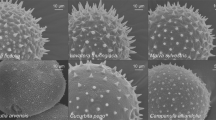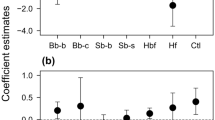Abstract
Female bees store scattered pollens grains from their bodies for transport by different modes of grooming and pollen packing. Species with corbiculae, such as honey or bumble bees, compress grains into dense pellets borne on the hind tibiae. Other species sweep grains into local concentrations of hairs (scopae), typically around the legs (in Halictidae and Andrenidae) or the ventral abdomen (Megachilidae), in which grains remain loose. Do these modes of pollen packing affect the functional value of pollen? We transferred grains from the bodies of four groups of bees—the corbiculate bees: Bombus impatiens and Apis mellifera, and the non-corbiculate bees: Megachile rotundata and Halictus spp.—onto previously unvisited stigmas of Brassica rapa. We wiped corbicular or scopal pollen and body pollen from each bee’s body separately and measured the resulting fruit set and the number of seeds in successful fruits. The type of pollen significantly affected the number of fruits for the corbiculate bee species but not the non-corbiculate bees, and the type of pollen significantly affected the number of seeds in successful fruits for A. mellifera but not B. impatiens, M. rotundata, or Halictus spp. These results suggest that loose scopal pollen is fully functional, but corbicular pollen is sometimes impaired. In some situations, non-corbiculate bees may be more valuable pollinators than corbiculate species because their treatment of pollen leaves its capabilities intact.

Similar content being viewed by others
References
Alspach PA, Pyke NB, Morgan CGT, Ruth JE (1992) Influence of application rates of bee-collected pollen on the fruit size of kiwifruit. N Z J Crop Hortic Sci 19:19–24
Beattie A (1971) Pollination mechanisms in Viola. New Phytol 70:343–360
Bosch J (1992) Floral biology and pollinators of three co-occurring Cistus species (Cistaceae). Bot J Linn Soc 109:39–55
Darwin C (1864) On the sexual relations of the three forms of Lythrum salicaria. J Proc Linn Soc Lond Bot 8:169–196
Fournier DA, Skaug HJ, Ancheta J et al (2012) AD model builder: using automatic differentiation for statistical inference of highly parameterized complex nonlinear models. Optim Methods Softw 27:233–249
Hall DB (2004) Zero-inflated poisson and binomial regression with random effects: a case study. Biometrics 56:1030–1039
Harder LD, Wilson WG (1998) Theoretical consequences of heterogeneous transport conditions for pollen dispersal by animals. Ecology 79:2789–2807
Jesson LK, Barrett SCH (2005) Experimental tests of the function of mirror-image flowers. Biol J Linn Soc 85:167–179
Kendall DA (1973) The viability and compatibility of pollen on insects visiting apple blossom. J Appl Ecol 10:847–853
Kraai A (1962) How long do honey-bees carry germinable pollen on them? Euphytica 11:53–56
Mesquida J, Renard M (1989) Étude de l“aptitude à germer in vitro du pollen de colza (Brassica napus L.) récolté par l”abeille domestique (Apis mellifica L.). Apidologie 20:197–205
Michener C (1979) Biogeography of the bees. Ann Mo Bot Gard 66:277–347
Michener CD (1999) The corbiculae of bees. Apidologie 30:67–74
Michener CD (2000) The bees of the world. Johns Hopkins University, Baltimore
Min YY, Agresti A (2005) Random effect models for repeated measures of zero-inflated count data. Stat Model 5:1–19
R Development Core Team (2013) R: A language and environment for statistical computing. R foundation for statistical computing, Vienna, Austria. http://www.R-project.org/
Stanley RG, Linskens HF (1974) Pollen: biology, biochemistry, management. Springer, Berlin
Thomson JD, Plowright RC (1980) Pollen carryover, nectar rewards, and pollinator behavior with special reference to Diervilla lonicera. Oecologia 46:68–74
Thomson J, Wilson P, Valenzuela M, Malzone M (2000) Pollen presentation and pollination syndromes, with special reference to Penstemon. Plant Species Biol 15:11–29
Thorp R (1979) Structural, behavioral, and physiological adaptations of bees (Apoidea) for collecting pollen. Ann Mo Bot Gard 66(4):788–812
Thorp R (2000) The collection of pollen by bees. Plant Syst Evol 222:211–223
Tyagi RK, Rangaswamy NS (1993) Screening of pollen grains vis-à-vis whole plants of oilseed brassicas for tolerance to salt. Theor Appl Genet 87:343–346
Vaissière BE, Malabœuf F, Rodet G (1996) Viability of cantaloupe pollen carried by honeybees Apis mellifera varies with foraging behavior. Naturwissenschaften 83:84–86
Vaknin Y, Gan-Mor S, Bechar A et al (2000) The role of electrostatic forces in pollination. Plant Syst Evol 222:133–142
Vallejo-Marín M, Manson JS, Thomson JD, Barrett SCH (2009) Division of labour within flowers: heteranthery, a floral strategy to reconcile contrasting pollen fates. J Evol Biol 22:828–839
Westerkamp C (1991) Honeybees are poor pollinators—why? Plant Syst Evol 177:71–75
Acknowledgments
We thank Mimi Draguleasa and Jeffrey Chen for field assistance; the staff at Koffler Scientific Reserve at Joker’s Hill, especially John Jensen, for help with field and laboratory logistics; and Emily Austen for providing seeds and advice. We are grateful to Jane Ogilvie, Natalie Jones, Jonathan Massey, and Kathleen Ogden for providing feedback on early drafts and to Neal Williams for valuable discussions. Natural Sciences and Engineering Research Council of Canada (NSERC) funded this research (Discovery Grants to J.D.T. and A.E.W).
Author information
Authors and Affiliations
Corresponding author
Additional information
Handling Editors: Neal Williams and Heikki Hokkanen.
Rights and permissions
About this article
Cite this article
Parker, A.J., Tran, J.L., Ison, J.L. et al. Pollen packing affects the function of pollen on corbiculate bees but not non-corbiculate bees. Arthropod-Plant Interactions 9, 197–203 (2015). https://doi.org/10.1007/s11829-015-9358-z
Received:
Accepted:
Published:
Issue Date:
DOI: https://doi.org/10.1007/s11829-015-9358-z




